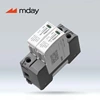How To Choose The Primary Surge Protector For Distribution Box
Recently, many customers have asked us how to choose a primary surge protector? How to determine whether the on-site distribution box should be equipped with a primary surge protector? How to determine some basic functions and parameters? Today, the editor will give you a detailed introduction on how to choose a primary surge protector.
1. What is a primary surge protector?
Primary surge protection refers to a T1-type test SPD with a 10/350µs waveform impulse current, so it is also called a T1-level surge protector. It discharges the huge energy when the power transmission line is directly struck by lightning, effectively protecting the electrical equipment inside the building from damage by surge current. Therefore, the assessment of the primary surge protector is mainly its discharge capacity.
Article 3 of Section 5.4.3 of GB 50343-2012 stipulates: For AC power supply lines entering buildings, at the junction of LPZ 0A or LPZ 0B and LPZ 1, such as the main distribution box of the line, a surge protector of Class I test should be installed as the first level of protection; that is, the first-level surge protector is usually installed in areas with high risk of direct lightning strikes, such as external power lines of buildings, independent main distribution boxes, main incoming lines of main distribution cabinets, low-voltage side of transformers, etc.
2. How to correctly choose a first-level surge protector?
The key parameters of a first-level surge protector include impulse current Iimp, maximum continuous working voltage Uc, voltage protection level Up, etc.
Article 8 of Section 4.2.3 of GB 50057-2012: A surge protector of Class I test should be installed at the main distribution box where the power supply is introduced. The voltage protection level value of the surge protector should be ≤2.5kV. When the impact current value of each protection mode cannot be determined, the impact current should be ≥12.5kA.
1. Limp impact discharge current refers to the flow rate of the T1 type surge protector, that is, the discharge capacity. For the first-level surge protector, the impact discharge current Iimp is commonly used in 15kA and 25kA specifications;
2. The Up voltage protection level is required to be ≤2.5kV, because the withstand voltage value of the protected equipment in the main distribution box is generally 2.5kV or 4kV. At present, the Iimp value of the first-level surge protector of the 230/400V distribution system on the market is 12.5kA ~ 50kA, and most of them can meet Up≤2.5kV. The lower the voltage protection level value, the better the protection performance. However, for high voltage systems such as 690VAC, 800VAC, etc., the voltage protection level Up>2.5kV is normal, as long as the effective protection level Up/f on the line is less than the withstand voltage value of the protected equipment;
3. The maximum continuous working voltage Uc of the surge protector should be selected according to the system voltage. The maximum continuous working voltage Uc should be greater than the system working voltage. For 220V/380V three-phase distribution system, Uc is often selected as 385V. The preferred values of Uc in the national standard are:
2. How to choose a safe and reliable primary surge protector?
1. When there is no surge in the power system, the SPD should not affect the working characteristics of the system to which it is applied;
2. Fault indication: Since the failed SPD has almost no effect on the system, it is difficult to be found. Therefore, a fault indication function is required to ensure that the failed SPD is replaced before the next surge arrives to protect the system from lightning current shock (switch-type primary surge protectors usually do not have this function);
3. No working continuous flow: Due to historical reasons, there are currently three types of primary surge protection on the market in my country, namely switch type, voltage limiting type, and composite type. Among them, the composite type has the advantages of high discharge capacity of the switch type and low residual pressure of the voltage limiting type, without the defects of continuous flow of the switch type and short leakage current life of the voltage limiting type. The emergence of the composite primary surge protector represents that the production level of my country's lightning arresters has reached the same level as the world's lightning arrester brands, greatly improving the protection ability of the distribution box against surges, while ensuring that the surge protector does not affect the normal power supply on the line, allowing the distribution system to operate stably.











